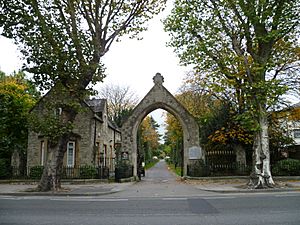Royal Borough of Kensington and Chelsea Cemetery, Hanwell facts for kids

Main entrance to the cemetery
|
|
| Details | |
|---|---|
| Established | 1855 |
| Location |
31 Uxbridge Road, Hanwell London W7 3PX
|
| Country | England |
| Type | Public |
| Owned by | Royal Borough of Kensington and Chelsea |
| Size | 7.7 hectares (19 acres) |
The Royal Borough of Kensington and Chelsea Cemetery, Hanwell (also called Hanwell Cemetery) is a burial ground in Hanwell, London, England. You can find it on the north side of the Uxbridge Road.
Contents
History of Hanwell Cemetery
Why the Cemetery Was Built
Even though it's in the London Borough of Ealing, this cemetery was started in 1855. The St Mary Abbots parish in North Kensington created it. They needed more space because their own burial grounds were getting full.
Also, people started to worry about health. They thought that burials inside busy London could spread diseases. So, a law called the Burial Act 1857 was passed. This law said that new burials should happen outside the crowded parts of London. Hanwell Cemetery helped with this.
Cemetery Design and Features
The cemetery is on the east side of Hanwell, near West Ealing. You can still see the old boundary stones there.
It was designed in a Victorian style, like a beautiful park. It has many curving paths and different kinds of trees. You'll see yew, pine, and oak trees all around. Tall cedars on the edges make the place look interesting. This is much nicer than just rows of graves.
The main entrance is a tall stone arch with heavy iron gates. There's also a lodge, which is a small building, nearby. A long path lined with evergreen yew, holly, and box plants leads to the burial areas. The chapel is in the middle of the cemetery.
The chapel, lodge, and arch were all designed by Thomas Allom. His name is carved on top of the arch. These buildings are made of Kentish Ragstone and look like old Gothic churches.
Ownership Over Time
Later, the Metropolitan Borough of Kensington took over the cemetery. They also opened another cemetery in Acton in 1926. Today, the Royal Borough of Kensington and Chelsea owns and manages the cemetery.
Nature and Wildlife at the Cemetery
East Field and the Hidden Brook
Before this land became a cemetery, it was a rich common area called East Field. A very small brook starts from a spring nearby. This brook now flows underground through a culvert. It runs under the cemetery towards the Uxbridge Road.
A Peaceful Home for Birds
The cemetery is far from busy main roads. The many trees offer shelter, and it's generally a quiet place. Because of this, it has become a safe haven for wild birds.
The London Borough of Ealing sees this cemetery as part of a special "conservation corridor." This means it's connected to the nearby Westminster City Cemetery, Hanwell across the Uxbridge Road. Together, they create an important area for nature.
Famous People Buried Here
Many interesting people are buried at Hanwell Cemetery. Here are a few:
- James Charles Inglis (1851–1911): He was a British civil engineer. His memorial is very tall and has a carved picture of him.
- Edgar Albert Smith (1847–1916): He was a conchologist, which means he studied shells and mollusks.
- John Conolly (1794–1866): A doctor who helped people with mental health. He was a leader at the Hanwell Asylum. He was buried here when local people could still be buried in the cemetery.
- Sir Charles Ash Windham: Known as the "Hero of the Redan."
- Sir Francis McClintock (1819–1907): An Irish explorer of the Arctic. He led an expedition in 1857-59. This trip confirmed what happened to Sir John Franklin, another famous explorer.
- Marta Cunningham (died 1937): She started the Not Forgotten Association [1] in 1921. This group helps ex-servicemen from the Great War and is still active today.
War Graves
The cemetery is also the resting place for 65 Commonwealth service members from both World Wars. Many of them are buried in a special war graves plot. Their headstones are cared for by the CWGC. There is also a Screen Wall memorial. This lists the names of those whose graves could not have individual headstones.
Gallery



